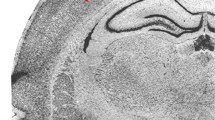Summary
The results are presented of serological examinations in a total of 4235 subjects including blood donors (341 persons), pregnant women (1784), newborns (833), patients with malignant tumours (248), patients with influenza-like diseases (548), patients with abacterial meningitis (295), infants under one year with hydrocephalus (40), infants under two years with other nervous system diseases (110), mothers of seropositive children with hydrocephalus (12) and mothers of seronegative children with hydrocephalus (24). The investigations revealed 16 cases of serologically confirmed prenatal lymphocytic choriomeningitis virus infection. Immunofluorescent antibody to this virus was detected in the children in most cases at high titers and in their mothers at moderate and low titers. In 14 children hydrocephalus was manifest, one child was suffering from infantile cerebral palsy, and one child from congenital right side blepharoptosis. Foci of chorioretinal degeneration were found in 14 patients. During pregnancy six mothers had an influenza-like illness; the other ten mothers denied any disease associated with fever.
Zusammenfassung
Es werden die Ergebnisse serologischer Untersuchungen an insgesamt 4235 Personen dargelegt, darunter Blutspender (341 Personen), Schwangere (1784), Neugeborene (833), Patienten mit malignen Tumoren (248), Patienten mit grippeähnlichen Krankheiten (548), Patienten mit abakterieller Meningitis (295), Kinder unter einem Jahr mit Hydrozephalus (40), Kinder unter zwei Jahren mit anderen Erkrankungen des Nervensystems (110), Mütter von sereopositiven Kindern mit Hydrozephalus (12) und Mütter von seronegativen Kindern mit Hydrozephalus (24). Die Untersuchungen ergaben 16 Fälle von serologisch verifizierter pränataler Infektion durch das LCM-Virus. Ein immunfluoreszierender Antikörper gegen dieses Virus wurde bei den Kindern in den meisten Fällen bei hohen Titern und bei ihren Müttern bei mäßigen und niedrigen Titern festgestellt. Bei 14 Kindern trat Hydrozephalus eindeutig in Erscheinung. Ein Kind litt an zerebralem Kinderlähmungs-Syndrom und ein Kind an angeborener rechtsseitiger Ptosis. Bei 14 Patienten fanden sich Herde chorioretinaler Entartung. Während der Schwangerschaft hatten sechs Mütter grippeähnliche Krankheiten, die restlichen zehn Mütter verneinten jegliche mit Fieber einhergehende Erkrankung.
Similar content being viewed by others
Literature
Armstrong, C., Lillie, R. D. Experimental lymphocytic choriomeningitis of monkeys and mice produced by a virus encountered in studies of the 1933 St. Louis encephalitis epidemic. Public Health Rep. (Wash.) 49 (1934) 1019–1027.
Rowe, W. P., Murphy, P. A., Bergold, G. H., Casals, J., Hotchin, J., Johnson, K. M., Lehmann-Grube, F., Mims, C. A., Traub, E., Webb, P. A. Arenoviruses: Proposed name for a newly defined virus group. J. Virol. 5 (1970) 651–652.
Traub, E. Über die immunologische Toleranz bei der lymphozytären Choriomeningitis der Mäuse. Zbl. Bakteriol. I. Orig. 177 (1960) 472–487.
Oldstone, M. B. A., Dixon, F. J. Persistent lymphocytic choriomeningitis viral infection. III. Virus-anti-viral antibody complexes and associated chronic disease following transplacental infection. J. Immunol. 105 (1970) 829–837.
Traub, E. An epidemic in a mouse colony due to the virus of acute lymphocytic choriomeningitis. J. Exp. Med. 63 (1936) 533–546.
Komrower, G. M., Williams, B. L., Stones, P. B. LCM in the newborn. Probable transplacental infection. Lancet (1955 I) 697–698.
Kantorovitch, R. A., Rezepova, A. J., Volodina, V. J.: Cogenital virus infections. Vestnik AMN SSSR Nr. 2 (1973) 17–28.
Blattner, R. J., Williamson, A. P., Heys, F. M. Role of viruses in the ethiology of congenital malformations. Progr. Med. virol. 15 (1973) 1–41.
Ackermann, R., Körver, G., Turss, R., Wönne, R., Hochgesand, P. Pränatale Infektion mit dem Virus der lymphozytären Choriomeningitis — Bericht über 2 Fälle. Dtsch. med. Wschr. 99 (1974) 629–632.
Sheinbergas, M. M., Tulevičiene, P. J., Kleiziene, Č. L., Vorobjova, Z. N.: Antibody to lymphocytic choriomeningitis virus in children with congenital hydrocephalus and in their mothers. Material of the Allunion conference of physicians for diseases of children (1974) 270–272.
Sheinbergas, M. M. Antibody to lymphocytic choriomeningitis virus in children with congenital hydrocephalus. Acta Virol. (Praha) 19 (1975) 165–166.
Sheinbergas, M. M.: The role of lymphocytic choriomeningitis virus in the ethiology of congenital hydrocephalus. Voprosi Virusol. Nr. 1 (1976) 94–99.
Sheinbergas, M. M., Čibiriene, I. K., Sverdlov, J. M.: Hydrocephalus and chorioretinal degeneration—the main syndrome of prenatal infection with the choriomeningitis virus. Pediatrija (1976) in press.
Cohen, S. M., Triandaphilli, J. A., Barlow, J. L., Hotchin, J. Immunofluorescent detection of antibody to lymphocytic choriomeningitis virus in man. J. Immunol. 96 (1966) 777–784.
Sheinbergas, M. M.: Detection of persistent infection of stable cell cultures with an agent related to lymphocytic choriomeningitis virus. Voprosi virusol. Nr. 2 (1975) 215–220.
Gajdamovich, S. Y.: Studies of neuroviruses in house rodents. I. Infection of house mice with lymphocytic choriomeningitis virus. Voprosi virusol. Nr. 3 (1958) 171–172.
Sheinbergas, M. M., Ptashekas, R. S., Pikelyte, R. L., Sverdlov, J. M., Čibiriene, I. K.: Clinical and pathomorphological data in two cases of prenatal infection with LCM virus. In preparation.
Lewis, V. J., Walter, P. D., Tracker, W. L., Winkler, W. G. Comparison of three tests for the serological diagnosis of lymphocytic choriomeningitis virus infection. J. Clin. Microb. 2 (1975) 193–197.
Scheid, W., Ackermann, R., Jochheim, K. A. Die Bedeutung der komplementbindenden und der neutralisierenden Antikörper für die Diagnose der Infektionen mit dem Virus der lymphozytären Choriomeningitis. Dtsch. med. Wschr. 84 (1969) 1293–1296.
Ackermann, R.: Epidemiologic aspects of lymphocytic choriomeningitis in man. Lymphocytic choriomeningitis virus and other arenaviruses. Ed. Lehmann-Grube F. 1973, 233–237.
Ackermann, R., Stammler, A., Armbruster, B. Isolierung von Virus der lymphozytären Choriomeningitis aus Abrasionsmaterial nach Kontakt der Schwangeren mit einem Syrischen Goldhamster (Mesocricetus aurcatus). Infection 3 (1975) 47–49.
Biggar, R. J., Woodall, J. P., Walter, P. D., Haughie, G. E. Lymphocytic choriomeningitis virus outbreak associated with pet hamsters. J. Amer. med. Ass. 232 (1975) 494–500.
Deibel, R., Woodall, J. P., Decher, W. J., Schryver, G. D. Lymphocytic choriomeningitis virus in man. Serologic evidence of association with pet hamsters. J. Amer. med. Ass. 232 (1975) 501–504.
Ackermann, R., Stille, W., Blumenthal, W., Helm, E. B., Keller, K., Baldus, O. Syrische Goldhamster als Überträger von lymphozytären Choriomeningitis. Dtsch. med. Wschr. 97 (1972) 1725–1731.
Author information
Authors and Affiliations
Rights and permissions
About this article
Cite this article
Sheinbergas, M. Hydrocephalus due to prenatal infection with the lymphocytic choriomeningitis virus. Infection 4, 185–191 (1976). https://doi.org/10.1007/BF01638922
Received:
Issue Date:
DOI: https://doi.org/10.1007/BF01638922




